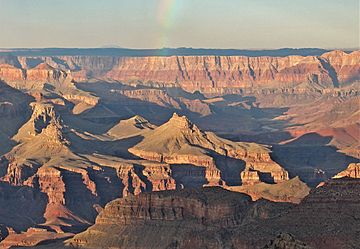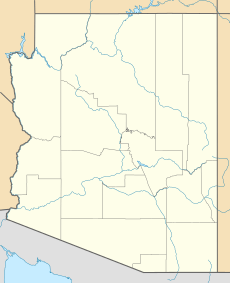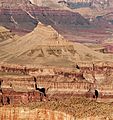Solomon Temple (Grand Canyon) facts for kids
Quick facts for kids Solomon Temple |
|
|---|---|

Solomon Temple centered in bullseye.
Southwest aspect, from Grandview Point. |
|
| Highest point | |
| Elevation | 5,121 ft (1,561 m) |
| Prominence | 661 ft (201 m) |
| Isolation | 1.41 mi (2.27 km) |
| Parent peak | Rama Shrine (6,406 ft) |
| Geography | |
| Location | Grand Canyon National Park Coconino County, Arizona, US |
| Parent range | Kaibab Plateau Colorado Plateau |
| Topo map | USGS Cape Royal |
| Type of rock | limestone, sandstone, shale |
Solomon Temple is a tall peak, or summit, in the amazing Grand Canyon. It stands 5,121 feet (about 1,561 meters) high. You can find it in Coconino County, in northern Arizona, USA.
This peak is located about four miles north of Moran Point. It is also 3.5 miles east of Newberry Butte. Solomon Temple rises very steeply, about 2,500 feet (760 meters) from the Colorado River below. This dramatic rise happens in less than one mile!
Contents
How Did Solomon Temple Get Its Name?
Solomon Temple was named after the famous historical king, Solomon. A geologist named François E. Matthes gave it this name. He was following a tradition started by Clarence Dutton. Dutton liked to name Grand Canyon features after gods and heroes from myths.
The name "Solomon Temple" became official in 1906. The U.S. Board on Geographic Names approved it.
What Is Solomon Temple Made Of?
Solomon Temple is a type of mountain called a butte. A butte is a tall, flat-topped hill with steep sides. This butte is mostly made of a rock called Redwall Limestone. This limestone formed during the Mississippian period, a very long time ago.
Below the limestone, you can find shale from the Cambrian Tonto Group. There's even a special rock layer called the Solomon Temple Member of the Dox Formation. It was named because it can be seen clearly near this butte.
What Is the Climate Like?
The area around Solomon Temple has a Cold semi-arid climate. This means it's usually dry, but not a true desert. It can get cold, especially in winter.
Gallery







